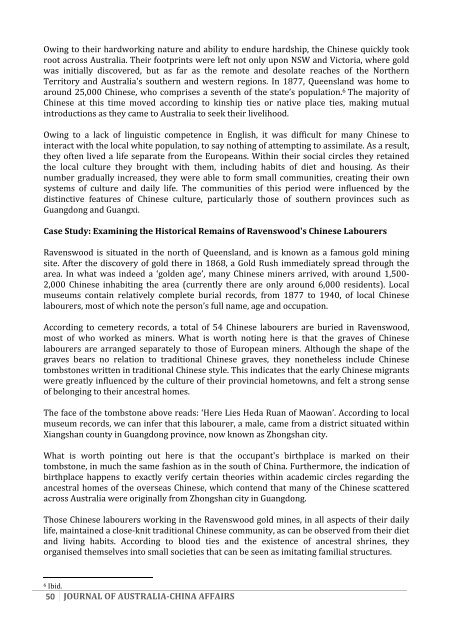Journal of Australia-China Affairs 2014
Journal of Australia-China Affairs 2014
Journal of Australia-China Affairs 2014
Create successful ePaper yourself
Turn your PDF publications into a flip-book with our unique Google optimized e-Paper software.
Owing to their hardworking nature and ability to endure hardship, the Chinese quickly took root across <strong>Australia</strong>. Their footprints were left not only upon NSW and Victoria, where gold was initially discovered, but as far as the remote and desolate reaches <strong>of</strong> the Northern Territory and <strong>Australia</strong>'s southern and western regions. In 1877, Queensland was home to around 25,000 Chinese, who comprises a seventh <strong>of</strong> the state’s population. 6 The majority <strong>of</strong> Chinese at this time moved according to kinship ties or native place ties, making mutual introductions as they came to <strong>Australia</strong> to seek their livelihood. Owing to a lack <strong>of</strong> linguistic competence in English, it was difficult for many Chinese to interact with the local white population, to say nothing <strong>of</strong> attempting to assimilate. As a result, they <strong>of</strong>ten lived a life separate from the Europeans. Within their social circles they retained the local culture they brought with them, including habits <strong>of</strong> diet and housing. As their number gradually increased, they were able to form small communities, creating their own systems <strong>of</strong> culture and daily life. The communities <strong>of</strong> this period were influenced by the distinctive features <strong>of</strong> Chinese culture, particularly those <strong>of</strong> southern provinces such as Guangdong and Guangxi. Case Study: Examining the Historical Remains <strong>of</strong> Ravenswood's Chinese Labourers Ravenswood is situated in the north <strong>of</strong> Queensland, and is known as a famous gold mining site. After the discovery <strong>of</strong> gold there in 1868, a Gold Rush immediately spread through the area. In what was indeed a ‘golden age’, many Chinese miners arrived, with around 1,500-‐2,000 Chinese inhabiting the area (currently there are only around 6,000 residents). Local museums contain relatively complete burial records, from 1877 to 1940, <strong>of</strong> local Chinese labourers, most <strong>of</strong> which note the person’s full name, age and occupation. According to cemetery records, a total <strong>of</strong> 54 Chinese labourers are buried in Ravenswood, most <strong>of</strong> who worked as miners. What is worth noting here is that the graves <strong>of</strong> Chinese labourers are arranged separately to those <strong>of</strong> European miners. Although the shape <strong>of</strong> the graves bears no relation to traditional Chinese graves, they nonetheless include Chinese tombstones written in traditional Chinese style. This indicates that the early Chinese migrants were greatly influenced by the culture <strong>of</strong> their provincial hometowns, and felt a strong sense <strong>of</strong> belonging to their ancestral homes. The face <strong>of</strong> the tombstone above reads: ‘Here Lies Heda Ruan <strong>of</strong> Maowan’. According to local museum records, we can infer that this labourer, a male, came from a district situated within Xiangshan county in Guangdong province, now known as Zhongshan city. What is worth pointing out here is that the occupant's birthplace is marked on their tombstone, in much the same fashion as in the south <strong>of</strong> <strong>China</strong>. Furthermore, the indication <strong>of</strong> birthplace happens to exactly verify certain theories within academic circles regarding the ancestral homes <strong>of</strong> the overseas Chinese, which contend that many <strong>of</strong> the Chinese scattered across <strong>Australia</strong> were originally from Zhongshan city in Guangdong. Those Chinese labourers working in the Ravenswood gold mines, in all aspects <strong>of</strong> their daily life, maintained a close-‐knit traditional Chinese community, as can be observed from their diet and living habits. According to blood ties and the existence <strong>of</strong> ancestral shrines, they organised themselves into small societies that can be seen as imitating familial structures. 6 Ibid. 50 JOURNAL OF AUSTRALIA-‐CHINA AFFAIRS


